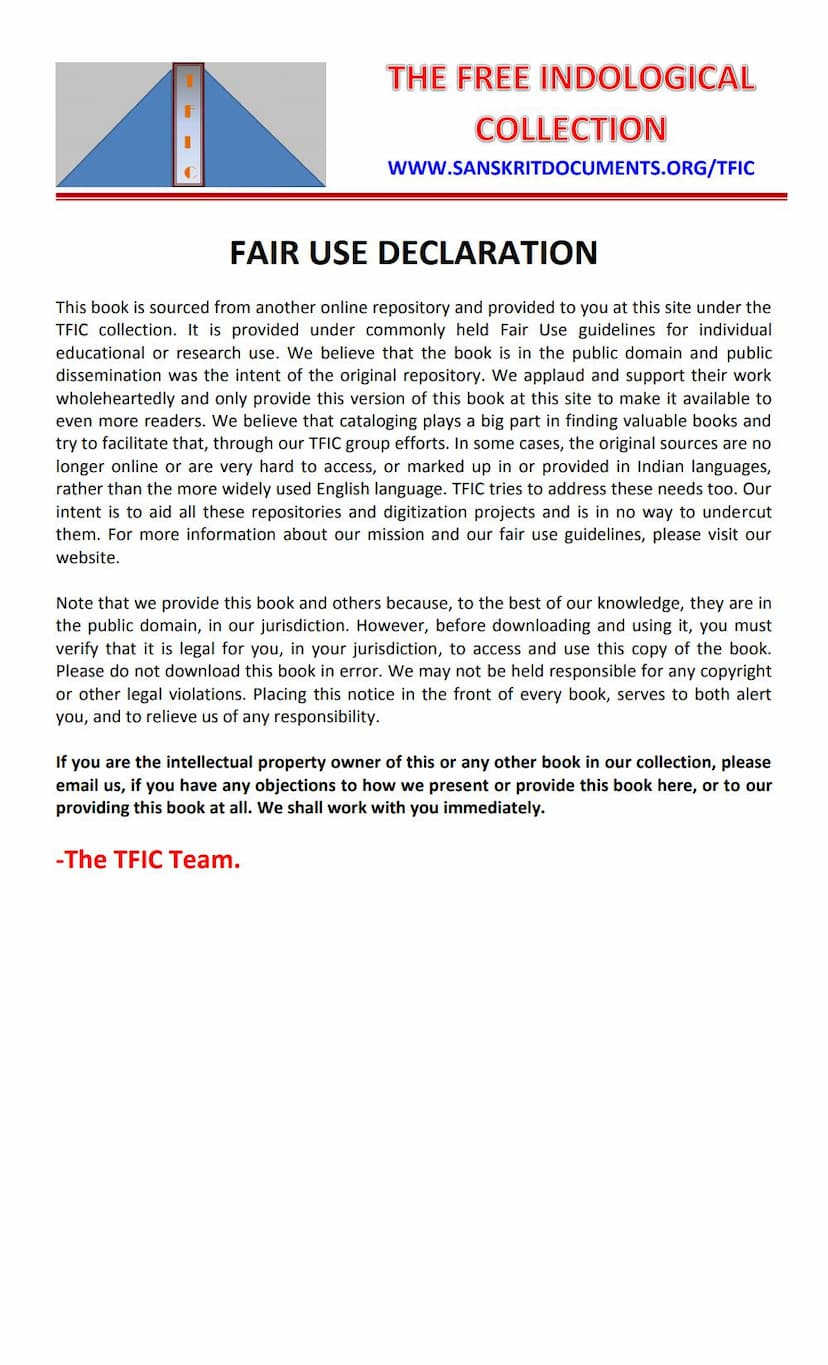Tattva Chintamani Anumankhandam
Added to library: September 2, 2025

Summary
This document is a detailed table of contents and partial transcription of the Tattva-Chintamani, specifically the Anumana Khanda (Section on Inference), authored by Gangeśa Upādhyāya, with commentary by Mathurānātha Tarkavāgīśa. The provided text focuses on the second part of the Anumana Khanda, covering topics from Anumiti (Inference) up to Badha (Contradiction).
The document begins with a Fair Use Declaration from The Free Indological Collection (TFIC), asserting that the book is provided for individual educational or research use and is believed to be in the public domain. It highlights the goal of making valuable books accessible, especially those in Indian languages or from hard-to-access sources.
The text then presents the title page of the book in Sanskrit and English. The English title is The Tattva-Chintamani, by Gaṅgeśa Upādhūya, Part II, Anumana Khanda, edited by Pandit Kamakhya Nath Tarkavagisa, from the commentaries of Mathuranatha Tarkayagisa. It was published in 1882 by the Asiatic Society of Bengal.
Following the title page, there is a Shuddhipatra (Correction Sheet) listing a series of corrections for the text, indicating inaccuracies in the original print and their rectified versions with page and line numbers.
The core of the document then delves into the Tattva-Chintamani, specifically the Anumana Khanda, focusing on the section titled Anumiti Nirupanam (Explanation of Inference).
Here's a breakdown of the key themes and discussions found in the text:
- Introduction to Anumana: The text begins by explaining the placement of the Anumana section after Pratyaksha (Perception) and before Upamana (Analogy), as per the consensus of many scholars, due to its dependence on perception.
- Definition of Anumiti: The text defines Anumiti as the knowledge arising from Vyapti-vishishta-pakshadharmata-jnana (knowledge of the presence of the middle term in the subject, qualified by its invariable concomitance with the predicate). Anumana itself is defined as the Lingaparamarsha (reflection on the middle term).
- Syngati (Connection): The text discusses the connection (syngati) between Pratyaksha and Anumana, stating that Anumana is pratyakshopajivaka (dependent on perception). It elaborates on how the knowledge of vyapti (invariable concomitance) in inference relies on perception.
- Rejection of certain definitions of Syngati: It discusses and refutes alternative definitions of syngati, emphasizing the direct and causal relationship between perception and inference.
- Definition of Anumiti (detailed): The text provides a precise definition of Anumiti, explaining the components like vyapti-prakaraka (having the character of universal concomitance) and pakshadharmata-jnana (knowledge of the middle term being present in the subject). It discusses how this definition avoids over-generalization (atikyapti) and under-generalization (avyapti) and applies to various types of inferences.
- Types of Anumana: Although the provided excerpt is primarily focused on the definition and mechanism of inference, the later parts of the text hint at different categories of inference (e.g., kevalanvayi, kevalavyatireki, anvayavyatireki) through the discussion of pakshata (the condition for inference).
- Pakshata (Probans): The text extensively discusses the conditions necessary for a valid inference, including the nature of the paksha (minor term) and the relationship between the hetu (middle term) and the sadhya (major term). It debates the placement and definition of pakshata.
- Vyakti (Invariable Concomitance): A significant portion is dedicated to defining and clarifying vyapti (invariable concomitance), exploring its various definitions and refuting inadequate ones. This includes discussions on avyabhicharita (non-fallaciousness), asadharana (non-exclusive), and other crucial logical concepts. The text analyzes different proposed definitions of vyapti, such as sadhyasamanadhikaranya ( concomitance with the major term) and sadhyavaidharmya (dissimilarity with the major term's negation).
- Upadhi (Coven): The concept of upadhi is introduced as a fallacious middle term that vitiates an inference. The text discusses the conditions under which something qualifies as an upadhi. It also touches upon the relationship between upadhi and vyabhichara (fallacy of the middle term).
- Hetvabhāsa (Fallacies of Inference): Later sections appear to discuss various fallacies of inference (hetvabhāsa), including sadhyavyabhichari (fallacy of the middle term not pervading the major term), viruddha (contradictory), anupasaṃhāri (unconcluded), viruddhahetu (contradictory reason), baadha (contradiction), and asiddha (unproved).
- Grahopaya (Means of Knowledge): The text briefly touches upon the means of knowing vyapti, discussing the role of repeated observation (bhūyodharśana) and logical reasoning (tarka).
- Arthāpatti (Postulation) and Anupalabdhi (Non-perception): The text also addresses and refutes the argument that arthāpatti (postulation) and anupalabdhi (non-perception) are independent means of knowledge, suggesting they can be explained within the framework of inference or perception.
In essence, the Anumana Khanda of the Tattva-Chintamani, as represented by this excerpt, is a foundational text in Indian logic (Nyaya and allied schools), rigorously analyzing the nature of inference, its valid conditions, and its potential fallacies. The commentary by Mathurānātha provides detailed explanations and clarifications of Gangeśa Upādhyāya's profound philosophical insights.